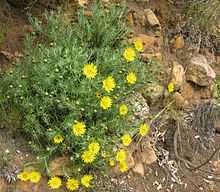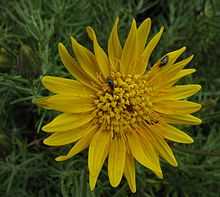Heterolepis
| Heterolepis | |
|---|---|
 | |
| Heterolepis aliena in native habitat fynbos | |
| Scientific classification | |
| Kingdom: | Plantae |
| (unranked): | Angiosperms |
| (unranked): | Eudicots |
| (unranked): | Asterids |
| Order: | Asterales |
| Family: | Asteraceae |
| Tribe: | Arctotideae [1] |
| Genus: | Heterolepis Cass. 1820 not Ehrenb. ex Boiss. 1884 (Poaceae)[2] |
| Type species | |
| Heterolepis aliena[1][3] Cass. | |
| Species | |
| |


Heterolepis is a genus of flowering plants in the sunflower family.[4] It has three[5] or four[6] species, all endemic to the Western Cape Province in South Africa.
Heterolepis species are shrublets, typically sprawling and about 30 cm high with moderately large yellow flowers. The flowerheads are solitary with glandular peduncles, the surrounding green bracts having membranous margins, especially in the inner rows. The ray florets are female, with a thread-like lobe opposite the ray. The disk florets are bisexual. The seeds (properly speaking the fruits) are flask-shaped, silky, with a pappus of two unequal rows of bristly, barbed scales. The leaves are alternate, typically 15–30 mm long, narrow or needle-like, sharply pointed, thick, and quite stiff, with the margins rolled under, woolly beneath. The rootstock is woody, and branches cobwebby. The plants occur mainly on rocky sandstone slopes in the mountains of the Western Cape in South Africa.[6]
The name Heterolepis is derived from two Greek words, heteros "different, dissimilar" and lepis "a scale".[7] This name was created in 1820 by Alexandre de Cassini [8][9] for a plant that had been named Arnica inuloides [10] by Martin Vahl in 1791.[11] One year after transferring this species to Heterolepis, Cassini changed the specific epithet, thus creating the superfluous combination Heterolepis decipiens in 1821.[12]
The relationships of Heterolepis to other genera in Asteraceae are not well understood. It is related to the tribe Arctotideae. Some authors have placed it within that tribe as a matter of convenience until more can be learned about it.[13]
References
- ↑ 1.0 1.1 Flann, C (ed) 2009+ Global Compositae Checklist
- ↑ Tropicos search for Heterolepis
- ↑ Heterolepis In: Index Nominum Genericorum. In: Regnum Vegetabile (see External links below).
- ↑ Per Ola Karis. 2007. "Arctotideae" pages 200-207. In: Klaus Kubitzki (series editor); Joachim W. Kadereit and Charles Jeffrey (volume editors). The Families and Genera of Vascular Plants volume VIII. Springer-Verlag: Berlin; Heidelberg, Germany. ISBN 978-3-540-31050-1
- ↑ David J. Mabberley. 2008. Mabberley's Plant-Book third edition (2008). Cambridge University Press: UK. ISBN 978-0-521-82071-4
- ↑ 6.0 6.1 Manning, John (2008). Field Guide to Fynbos. Cape Town: Struik Publishers. ISBN 978-1-77007-265-7.
- ↑ Umberto Quattrocchi. 2000. CRC World Dictionary of Plant Names volume II. CRC Press: Boca Raton; New York; Washington,DC;, USA. London, UK. ISBN 978-0-8493-2676-9 (vol. II). (see External links below).
- ↑ Heterolepis at the International Plant Names Index. (see External links below).
- ↑ Alexandre H.G. de Cassini. 1820. Bulletin des Sciences, par la Société Philomatique de Paris 1820:26.
- ↑ Arnica At: International Plant Names Index. (see External links below).
- ↑ Martin Henrichsen Vahl. 1791. Symbolae Botanicae part 2:91.
- ↑ Alexandre H.G. de Cassini. 1821. Dictionnaire des Sciences Naturelles, ··· . Strasbourg. edition 2. (F. Cuvier). 21:120.
- ↑ Vicki A. Funk, Alfonso Susanna, Tod F. Stuessy, and Randall J. Bayer. 2009. Systematics, Evolution and Biogeography of the Compositae. IAPT (International Association for Plant Taxonomy). ISBN 978-3-9501754-3-1 (see External links below).
External links
- CRC World Dictionary of Plant Names: D-L At: Botany & Plant Science At: Life Science At: CRC Press
- Heterolepis and Arnica At: Plant Names At: IPNI
- Heterolepis At:Index Nominum Genericorum At: References At: NMNH Department of Botany At: Research and Collections At: Smithsonian National Museum of Natural History
- Classification (compositae book, chapter 11 At: The International Compositae Alliance